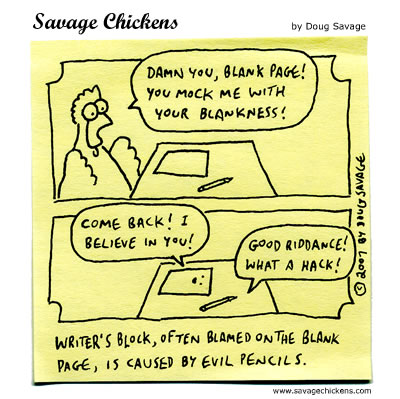It would be hard to improve upon Sandra Novack's piece on writer's block from yesterday's post. It offers such perfect advice from the practical to the profound. I particularly like the last suggestion: What is really going on here? Since I can't improve upon it, I want to share what I know about it from a different angle.
I was thinking about the idea of writer's block while taking a walk with my three children today. I kept coming back in my mind, over and over again, to the word "block," until I no longer thought the word, but saw the image of a block, a wooden one, sort of like the kind my children play with almost every day. Their wooden blocks are excellent for building towers, houses, roads, barns, cathedrals, as well as for getting left around for house visitors to trip on.
This is one of my children peering underneath a block creation. c. Sam Wilde
As I walked, I no longer focused on the idea of a block as something in the way of something else--like a roadblock--but as an object akin to a brick, something you would build with, something you could build on. What if writer's block is an opportunity, I started to muse. Then I thought of yoga and breathing.
One of the many breath practices I have learned and also taught in the yoga tradition focuses the mind on the space between the breaths. If you breathe in and breathe out, there is this infinitesimal moment of time between the in-breath and before the out-breath, and after the out-breath but before the in-breath. These tiny pauses can be prolonged, drawn out, and extended for what's usually called a retention of the breath. Breath retention is said to build energy, among other things.
What's interesting about the spaces between breath is that from the outside they look like nothing. Those are the moments when nothing is happening, no action, no apparent energy. Yet they are also the places where energy can build, as well as where peace can be found, the brief pause, a moment of non-doing, a rest.
I have always been a believer in rest. I constantly extol the virtues of sleep. Though I don't keep it perfectly myself, I do practice a Sabbath day. My family now lives across from several working farms. Two of the fields closest to us have been left fallow. They need it, for restoration, to regain equilibrium.
Perhaps it is possible that a writer's block is just that, a block to build upon, a pause from the doing, a space of being. It's so difficult in our culture to ever really stop doing, yet nothing, no animal or vegetable or mineral, can exist in a perpetual state of output. It might simply be a matter of an empty well that needs filling. Or it might be more interesting than that. Something might be happening in the empty spaces that we aren't the doers of.
Occasionally I end yoga class by pointing out, while students are in savasana or corpse pose, that they are being breathed. It's wonderful to take deep breaths and work on lengthening the breath, but for most of us, most of the day, the breath does itself. Wouldn't it be nice to allow for the possibility that on some level, one we can't immediately observe, writer's block is the moment in time when the writing is doing itself. Eventually we'll lay down a few more blocks. Only then will we be able to see the new structure and the foundation that began it.
Well...it could be. And if not, it seems an awfully nice way to think of something that can bring such frustration.
Any Zen stories of writer's block out there?
Samantha Wilde is the author of This Little Mommy Stayed Home. The mother of three young children, she lives in Western Massachusetts with her scientist husband where she spends most of her time hugging, scolding, cleaning, and cooking with the occasional glittering moments of teaching yoga, writing novels, and ministering, though for all her complaining there is nothing she'd rather be at this moment in time than "Mama." Her second novel will be out next February from Bantam Books.






.jpg)



















